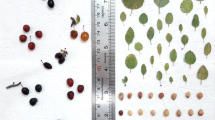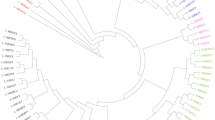Abstract
The aim of this research was to evaluate some old accessions of Cupressus sempervirens L. in Iran and identify any possible relationships exist among them based on phenotypical characteristics. A total of 17 Cupressus accessions mostly grown in situ, from Kerman and Yazd provinces were used. Twenty characteristics (11 quantitative and 9 qualitative) were measured for evaluating the chosen samples. Results from simple correlation analysis showed significant positive and negative correlations for certain important characteristics. Seed length and width were in significant correlation with cone width. There was a close relationship between seed length and width with cone width. Also seed length, seed width and number of total seeds were in significant correlation with cone circumference. The number of seeds per cone was in positive correlation with scale number per cone and number of seed per scale. Factor analysis was used to determine the effective characteristics and the number of main factors. For each factor, a loading value of more than 0.65 was judged as being significant. Effective characteristics were categorized into seven main factors that contributed to 85.5 % of the overall variance. Cone and seed characteristics were defined mainly by the first factor contributing to 25.62 % of the total variance. Cluster analysis divided the trees into two main clusters each consisting of genotypes with lanceolate leaves and ovate, respectively, exception to the thirty sub cluster of the first main cluster that had ovate leaves. The oldest accessions such as Y.A, Y.M, Y.Ch, Y.T1, Y.T2 and K.J1 were located in the first cluster. Most of the accessions, especially the oldest ones, in main first cluster had the open growth habit or semi-open, so that growth habit was semi-closed in second main cluster.

Similar content being viewed by others
References
Abrishami MH (2005) Cypress in Iran culture and Achaemenid inscriptions. In: Afshar I (ed) Iran researches (Memorandum of Mahmood Afshar), vol 15, pp 9–29
Adams RB (2001) Geographic variation in leaf essential oils and RAPDs of Juniperus polycarpos K. Kochin Central Asia. Biochem Syst Ecol 29:609–619
Afzal-Rafii Z, Dodd RS (1994) Biometrical variability of foliage and cone characters in Cupressus bakeri (Cupressaceae). Plant Syst Evol 192:151–163
Bagnoli F, Vendramin GG, Buonamici A, Doulis G, Gonzalez-Martinez C, La Porta N, Raddi P, Sebastiani F, Fineschi S (2009) Is Cupressus sempervirens native to Italy? An answer from genetic and paleobotanical data. Mol Eco 18:2267–2286
Eckenwalder JE (2009) Conifers of the world, the complete reference. Timber Press, Inc., Portland
Flake RH, Von-Rudloff E, Turner BL (1969) Quantitative study of clinal variation in Juniperus virginia using terpenoid data. Proc Nat Acad Sci USA 64:487–494
Giovanelli A, De Carlo A (2007) Micropropagation of Mediterranean cypress (Cupressus sempervirens L.). In: Jain SM, Haggman H (eds) Protocols for micropropagation of woody trees and fruits, pp 93–105
Karimi HR, Zamani Z, Ebadi A, Fatahi MR (2009) Morphological diversity of Pistacia species in Iran. Genet Resour Crop Evol 56:561–571
Marcysiak K, Mazur M, Montserrat ARJM, Didukh Y, Boratyn′ ska K, Jasin′ ska A, Kosin′ ski P, Boratyn′ ski A (2007) Numerical taxonomy of Juniperus thurifera, J. excelsa and J. foetidissima (Cupressaceae) based on morphological characters. Bot J Linnean Soc 155:483–495
Mazur M, Boratyn′ ska K, Marcysiak K, Go′mez D, Tomaszewski D, Didukh J, Boratyn′ ski A (2003) Morphological variability of Juniperus phoenicea (Cupressaceae) from three distant localities on Iberian peninsula. Acta Soc Bot Poloniae 72:71–78
Mosazadeh Sayadmahaleh F, Habibi Bibalani Gh (2010) Application of the Cypress in poems by Rodaki Samarghandi. Int J Acad Res 2:356–358
Mosazadeh-Sayadmahaleh F, Esmaeilzadeh-Estakhrbijar Y, Habibi Bibalani Gh (2011) Roles of Cypress in poems of Hafez. Inte J Acad Res 3:322–327
Mozaffarian VA (2003) A dictionary of Iranian plant names (Latin, English, Persian). Farhang-e-Moaser, Tehran
Ormon S, Silvio S, Thomas G (2010) Morphometric traits and sexual dimorphism do not strongly differentiate populations of Zeravshan juniper (Juniperus servschanica Kom.). Flora 205:532–539
Papagergiou AC, Panetsos KP, Hattermer HH (1994) Genetic differentiation of natural Mediterranean cypress (Cupressus sempervirens L.) populations in Greece. Forest Gen 1:1–12
Sabeti HA (2003) Forests, trees and shrubs of Iran. Publication Center of Science and Technology University, Tehran
Zamani Z, Sarkhosh A, Fatahi R, Ebadi A (2006) Genetic relationships among pomegranate genotypes studied by fruit characteristics and RAPD markers. J Hortic Sci Biotechnol 82:11–18
Zhang Q, Yang YZ, Wu GL, Zhang DY, Liu JQ (2008) Isolation and characterization of microsatellite DNA primers in Juniperus przewalskii Kom. (Cupressaceae). Conservation Genet 9:767–769
Author information
Authors and Affiliations
Corresponding author
Rights and permissions
About this article
Cite this article
Karimi, H.R., Farahmand, H. & Hashemipour, M. Morphological diversity of some old accessions of Cupressus sempervirens L. in Iran. Plant Syst Evol 299, 1379–1386 (2013). https://doi.org/10.1007/s00606-013-0803-0
Received:
Accepted:
Published:
Issue Date:
DOI: https://doi.org/10.1007/s00606-013-0803-0




